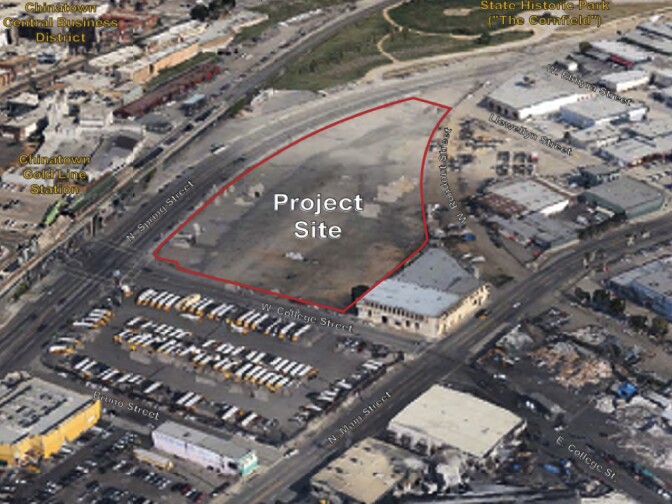With our free press under threat and federal funding for public media gone, your support matters more than ever. Help keep the LAist newsroom strong, become a monthly member or increase your support today.
Mega-project may skirt Chinatown 'smart' development rules
Chinatown and Lincoln Heights residents who spent years working to shape new affordable housing standards for their area are voicing dismay that one of the neighborhood's biggest parcels may sprout two 20-story residential towers.
The project is College Station, on five acres of vacant land east of the Chinatown Gold Line station, at Spring and College streets.
Owner Atlas Capital has proposed building two towers with up to 685 apartments. The project would include ground-level retail and restaurants, rooftop pools and a pedestrian plaza. They would become the tallest buildings in Chinatown.
The company declined to speak about the project for this story. But Tim Piasky, of the Building Industry Association, says the project would relieve upward pressure on rents for local residents by expanding the available supply of homes.
"Being able to get housing, especially the type of housing we're talking about in this area, that is close to job center, close to transit, it's the type of housing that everybody wants to see. So, it's really very important," Piasky said.
But Sissy Trinh, executive director of Southeast Asian Community Alliance, or SEACA, said the plan is a far more intense use than was contemplated in the 2013 Cornfields Arroyo Seco Specific Plan.
"The high-end supermarkets, the live-work lofts where a one-bedroom goes for $2,000 or even $3,000 these days... Not for families, not for seniors and definitely not for the low-income residents of Chinatown," Trinh said. "How is this serving the existing community as opposed to creating a harder standard of living because it's making everything else more expensive?"
SEACA is a local youth organizing group that pressed for incentives that would help preserve affordable housing in the area. The plan is called the Cornfields after the local nickname for Los Angeles State Historic Park.
When it was adopted in 2013, a Los Angeles Times editorial called it a "smart development" plan that should become a model for the city, one that would give residents of the area around Chinatown's Cornfields park a sense of certainty about future building plans.
The Cornfields plan has a system of incentives to require developers who want to build additional new homes in this area to also add more public benefits like affordable housing.
If built according to the Cornfields plan, the College Station parcel would be mostly commercial, retail and light industrial, with at most 200 homes. About 20 of the homes would need to be affordable to residents of the area, where the typical household income is about $20,000, said Senior City Planner Claire Bowin.
But Atlas Capital, one of downtown Los Angeles' biggest developers, will not be held to the Cornfields plan standards, Bowin said, because the company filed its application and a zone change request for the College Station project in 2012, a year before the Cornfields plan was approved.
The company will use the old zoning, which is industrial and manufacturing, and request a zone change to mixed use commercial and residential uses. The company offers to build up to 100 affordable units for seniors on the site, however, it is not clear if those units would be affordable for local residents.
Lucy Tang was a sophomore in 2009 when she began researching affordable housing options for the Cornfields plan with SEACA. She's frustrated that the first big project in line to be built under the Cornfields plan might bypass its requirements.
"It definitely would have an adverse impact on people like my friends and their families and similar to, like, my family, it would be really bad," Tang said. "That project is just so major, like, it'll set a precedent."
The College Station project is still in its initial stage. That means there are still public hearings left at which the developer and community residents can be heard.
Before building begins, the developers will need to complete an environmental impact report and receive a zone change approval before the city Planning Commission. Those hearings have not yet been scheduled.
Meanwhile, Bowin said, some of the incentives in the Cornfields plan are being used as a model for planners who are rewriting land use rules in other areas of the city like Boyle Heights and South Los Angeles, and along the Metro Expo line.
You can track the progress of the College Station application on the city's website.
This story has been updated.












